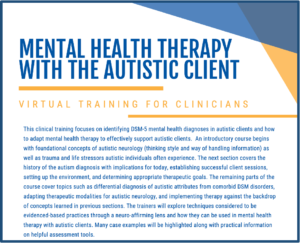Because autistics take in information from the world around them differently than the rest of the people in the world it is important to understand the way information comes in for an autistic individual. Though there are similarities amongst autistic people such as noise and light sensitivity, there also can be some individuality when it comes to how a particular autistic individual’s brain takes in information. Most times individuals cannot tell you how their brain functions. Again, this functioning happens automatically. There is no conscious decision when it comes to how a brain takes in information.
When information comes in too big it can be quite overwhelming. This happens frequently to many autistic people. Usually when a person has reached capacity in their ability to handle this ongoing sensory assault they react in a way that doesn’t fit into the neuromajority expectation. For example, one person may groan loudly, another may flap his hands and a still another may have either a meltdown or a shutdown. When any unexpected behavior occurs, it is most often assumed that the immediately preceding event or sensory assault caused it rather than understanding it is the continual sensory assault over time causing the “too much” to eventually spill over.
Example
For example, when the bell rang at the end of the class period Rita screamed and cleared her desk quickly swiping books and papers to the floor. Staff went to great lengths to get Rita to put on her noise canceling headphones 5 minutes before the bell rang everyday. Some days Rita took the offered headphones and other days she pushed them away.
Think of sensory information coming in too big as a glass of water filling up over time. Each little assault throughout the day adds to the water level in the glass. When the glass is full to the top the next assault that adds more water will cause the glass to overflow. This is what happened for Rita. Thus, it wasn’t the ringing bell that caused the behavior, but instead it was that the glass had overflowed. Her capacity to withstand another sensory assault had been maxed out.
Solutions
Trying to solve for the ringing of the bell will likely lead to nowhere, but solving
-
-
- to prevent sensory overload,
- to increase awareness of overload building and
- to teach self-advocacy options to be utilized when sensory overload starts to build
-
would all be great preventative options helpful in addressing this situation. Rita, just like most autistics, does not have a neurology that automatically regulates incoming information.
Conclusion
It is important to learn how an autistic individual takes in information. This allows us to fine tune and personalize the supports they might choose from to enable them to be who they want in this world, to function as they wish and to come to live a self-determined life.

Note: The author is a mental health therapist and is also autistic. She iintentionally uses identity-first language (rather than person-first language), and invites the reader, if interested, to do further research on the preference of most autistic adults to refer to themselves using identity-first language.
Selection from Autistically Thriving: Reading Comprehension, Conversational Engagement, and Living a Self-Determined Life Based on Autistic Neurology, pg. 135-136.
If you are a clinician and interested in learning more about therapy with the autistic client please join me along with two of my colleagues in an online course.
CLICK HERE for additional information about Mental Health Therapy with the Autistic Client.
BY JUDY ENDOW
Endow, J. (2021). Executive Function Assessment. McFarland, WI: Judy Endow.
Endow, J. (2019). Autistically Thriving: Reading Comprehension, Conversational Engagement, and Living a Self-Determined Life Based on Autistic Neurology. Lancaster, PA: Judy Endow.
Endow, J. (2012). Learning the Hidden Curriculum: The Odyssey of One Autistic Adult. Shawnee Mission, KS: AAPC Publishing.
Endow, J. (2006). Making Lemonade: Hints for Autism’s Helpers. Cambridge, WI: CBR Press.
Endow, J. (2013). Painted Words: Aspects of Autism Translated. Cambridge, WI: CBR Press.
Endow, J. (2009b). Paper Words: Discovering and Living With My Autism. Shawnee Mission, KS: AAPC Publishing.
Endow, J. (2009a). Outsmarting Explosive Behavior: A Visual System of Support and Intervention for Individuals With Autism Spectrum Disorders. Shawnee Mission, KS: AAPC Publishing.
Endow, J. (2010). Practical Solutions for Stabilizing Students With Classic Autism to Be Ready to Learn: Getting to Go. Shawnee Mission, KS: AAPC Publishing.
Myles, B. S., Endow, J., & Mayfield, M. (2013). The Hidden Curriculum of Getting and Keeping a Job: Navigating the Social Landscape of Employment. Shawnee Mission, KS: AAPC Publishing.
